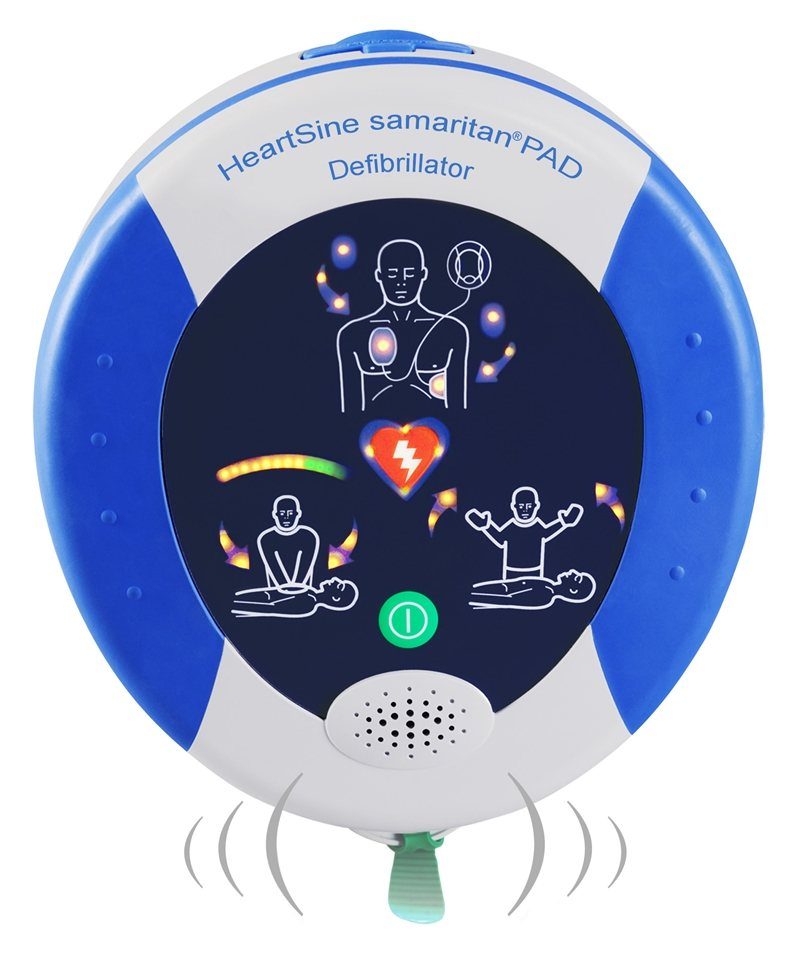HeartSine | SKU:
SAM017E
HeartSine Samaritan PAD 500P Automatic External Defibrillator (AED)
Regular price
£1,485.00
Unit price
/
Unavailable
Tax included
- Lightweight
- Easy to use
- Low cost of ownership
- Battery and Pad Pak last 4 years
HeartSine Samaritan PAD 500P Automatic External Defibrillator (AED) - Samaritan PAD 500P with 1 PAD PAK is backordered and will ship as soon as it is back in stock.
Couldn't load pickup availability
Delivery and Shipping
Delivery and Shipping
- UK and Irish orders over £60 are shipped free of charge* excluding pharmaceutical orders.
- Delivery method will be determined by Vivomed based on the value and size of the items ordered.
- Shipping methods used with estimated delivery times and other relevant information are listed on our Postage Information Page
Description
Description
The HeartSine samaritan® PAD with CPR Advisor model 500P? - with 2 PAD packs.
Please see videos below showing you how to use a HeartSine samaritan® 500p defibrillator (AED), how to set it up and a basic introduction to it.
Cardiopulmonary resuscitation is an integral part of any reaction to a Sudden Cardiac Arrest. ??
Sharing in features to the 350P, The HeartSine samaritan® 500P with CPR advisor offers clear and concise feedback on CPR compressions.?
Audio prompts of Push Harder, Push Faster Push Slower and Good Compressions guide the rescuer on the force and speed of CPR.?
Unlike other CPR support devices that claim to measure the force and speed of compressions PAD 500P with CPR advisor is the only device in the market to use impedance cardiogram (ICG) measurement of actual cardiac output to give feedback on CPR.
Defibrillation is easy, CPR is the hard part...??Regardless of whether it is a lay person or a professional rescuer, 70% of all CPR is carried out inadequately.?Now, HeartSine can provide a solution to this problem with the introduction of the HeartSine samaritan PAD with CPR Advisor model 500P.
CPR stands for Cardio (heart) Pulmonary (lung) Resuscitation which is a combination of pushing the heart to circulate blood to all the vital organs and breathing into?the victim to give them oxygen. There has been a lot of research into the best way to resuscitate a patient and the results of that have been built into the HeartSine® PAD500P guidance.
?
The HeartSine® PAD500P uses an Impedance Cardiogram (ICG) to assess how good the CPR is - are the compressions fast enough? Hard enough? The Impedance Cardiogram (ICG) measures Impedance changes in blood volume in the chest cavity which determines effective CPR. ??
Since the blood flow is related to how fast the compressions are applied as well as how hard, the PAD 500P can guide you on both - for example - 'push faster, good compressions' means the?compressions are too slow but the pressure is good.?Likewise, 'push harder' means more pressure is needed before concerning yourself with the speed. The simple objective is to ensure that the green indicators are on during CPR with the voice prompting 'good compressions. One amber light means that either CPR is not being applied at all, or it is too gentle and too slow. All amber lights?showing mean you are not applying enough pressure. All lights on mean you are pushing hard enough. The aural clicks will help you keep time. ??
However, if good CPR is to be achieved at all, it is really important that the electrodes and the hands are placed correctly as the device cannot remove the need for CPR training. The electrodes should be replaced by the Apex - underneath their left arm at the bottom of the ribcage, and the sternum - over the heart itself. Hands must be clasped and placed two fingers up from the bottom ?of the centre of the rib cage. Hands must not touch the electrodes. For this reason, HeartSine® strongly advises you to take a short training course on CPR which Vivomed can also supply as part of the purchase of a HeartSine AED.
To purchase an AED wall sign please follow this link
Please note, this is a UK/Ireland specification model and adheres to the MHRA and IMB guidelines.
HeartSine Samaritan PAD 500P Defibrillator (AED) Setup
How to use a HeartSine Samaritan PAD 500P Defibrillator (AED) Instructions
HeartSine Samaritan PAD 500P Defibrillator (AED) Introduction
For your replacement HeartSine Samaritan Pad-Pak please click here
- Lightweight
- Easy to use
- Low cost of ownership
- Battery and Pad Pak last 4 years
- Widely used in professional sport
Payment & Security
Payment methods
Your payment information is processed securely. We do not store credit card details nor have access to your credit card information.




